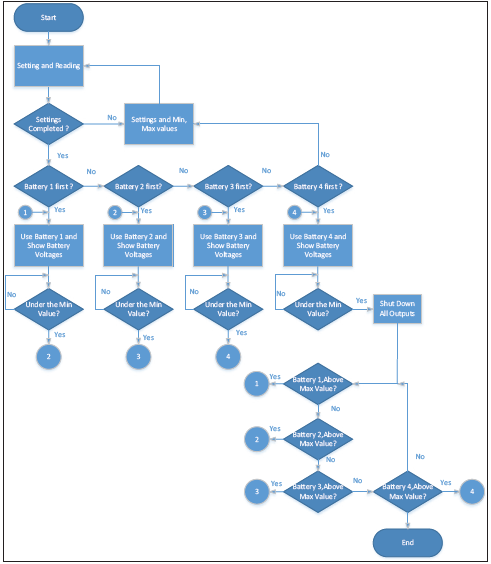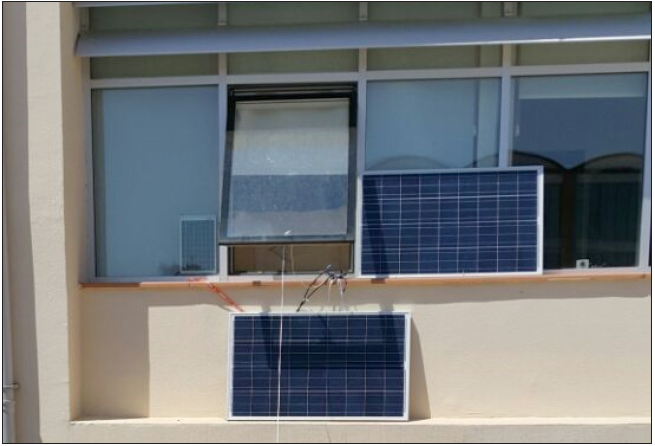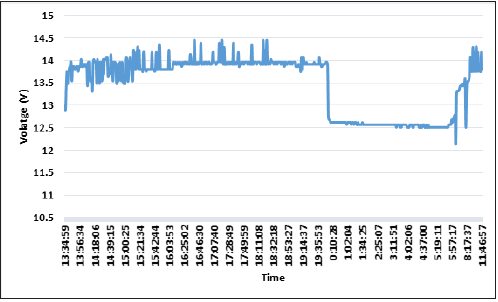- Submissions

Full Text
Evolutions in Mechanical Engineering
New Battery Management System and its Application
Fuat Kartal*
Faculty of Engineering and Architecture, Kastamonu University, Turkey
*Corresponding author:Fuat Kartal, Kastamonu University, Faculty of Engineering and Architecture, Mechanical Engineering Department, Turkey
Submission: September 18, 2021;Published: October 29, 2021

ISSN 2640-9690 Volume3 Issue5
Abstract
In this paper, application of a Battery Management System (BMS) with Battery Energy Storage System (BESS) is realized by using solar power. Proposed system is designed for four different 12V, 60Ah batteries used by general purpose as an uninterruptable power supply unit for electronics devices. Furthermore, in developed application, with respect to state of charge of each battery, either batteries are used as energy supply or batteries are charged by solar power. In addition to BMS, battery charger system in order to regulate battery charge voltage is applied. With the application in this paper, by controlling each batteries charge level, an efficient way to use of batteries are provided in order to have a long life
Keywords: Solar power; Battery management system; Battery storage system
Introduction
Recently, using of renewable energy especially solar energy because of decreasing
carbon based energy sources and their drawbacks to nature has gained much attention. Also,
solar energy is transferred to electrical energy in DC form by using solar panels- especially
Photovoltaic (PV). These energy is generally at first stored on batteries instead of direct
use due to changing of solar irradiation level in a day meaning demanded power may not
be supplied with direct use. However, batteries should be charged and discharged carefully
because of not to decrease their life time. This process can be supply by using BMS and BESS
systems. Therefore, BMS and BESS systems are vital in the application using batteries.
In literature, there are some papers about this eye catching topic as follows; Lawder et
al. [1] presents PV based BMS system using SOC calculation and temperature compensating
charging, data logger and LCD screen for stand alone application with one battery unit. Dual
battery storage bank configuration using solar energy based BMS making to operate one
battery as storage when solar energy is available and the other battery as balancing daily
needs and voltage regulation for islanded micro grids is proposed in [2]. Anand I et al. [3]
realizes dynamic power management system over single inductor dual input-output boost
DC-DC converter between battery as an energy storage, PV with MPPT and a DC load. Solar
power assisted battery balancing system providing the charging the battery and storage
element also balancing each element for electrical vehicle as in [4]. Hollinger R et al. [5]
examines the use of solar system with correct battery charging as a primary control reserve.
Power management system using adaptive dynamic programming-based optimal control
scheme increasing life time of battery system with solar energy is realized in [6]. Cacares
M et al. [7] realizes stand alone photovoltaic management system using 11.1V, 5200mAh
Ion-Lithium battery for information and communication technologies devices. A simulation
study is realized for stand alone battery charging and management system using 100W solar
panels as in [8]. Gupta NK et al. [9] propose smart solar energy management system for power
computer control lab using 4kW solar panel with 12V, 100Ah batteries. Energy management
system for rural micro grid including solar energy, wind energy, diesel generator and a battery
as a storage and supply for a load is realized in [10].
In this paper, application of BMS with BESS is realized by using solar power. This system is
designed for four different 12V, 60Ah battery used by general purpose as an uninterruptable
power supply unit for electronics devices. Furthermore, in developed application, with respect
to state of charge of each battery, either batteries are used as energy supply or batteries are charged by solar power. In addition to battery management system,
battery charger system in order to regulate battery charge voltage
is applied. With the application in this paper, by controlling each
batteries charge level, an efficient way to use of batteries are
provided in order to have a long life.
Material and Methods
In this paper, with the proposed BMS and BESS system, efficient use of batteries is aimed. In Figure 1, flowchart of the BMS algorithm for this study is shown. It is seen from that schema, BMS including BESS is designed for four batteries. Operation of the algorithm is as follows; at first, settings are defined for min and max values of battery charge voltage. Then, usage privileges that means chosen battery is used as a supply, is defined and all battery voltages are shown on LCD screen. Also, battery charge levels are checked by using min value and if the battery used as a supply has lower charge level than min value then the other battery is used as a supply in sequence with all batteries in BMS system and batteries having lower charge value is charged till they reached to max values. If all batteries has lower charge level than min value then it closes all outputs meaning that no usage of any batteries. Also it checks maximum charge values of batteries and it uses the battery having higher charge value than its max charge value. If all the batteries has higher value than their max value, it stops charging batteries.
Figure 1:Flowchart of BMS algorithm.

Finding and Results
Block diagram of the application of BMS and BESS system is shown in Figure 2. It is seen that energy obtained by PV is then regulated by battery charger to charge the batteries and BMS is used to efficient use of batteries and then batter energy feeds the load. Experimental set up is shown in Figure 3 & 4. Furthermore, in Figure 5 measurement of battery voltage for one day period is shown. This battery, measurement results given in Figure 5. is charged in day time by solar power and used after sunset between 19:38:54 to 05:39:30 on the lighting system. When the voltage level of the battery decreased to 12.5V at 05:39:30, another battery is taken for usage by BMS, and the used battery is charged by solar panel. Measurement in Figure 6. charge and discharge process of each of the batteries in sequence over BMS systems is shown. It proves that BMS system works as it desired. Whenever one of batteries charge level decreases, BMS takes for usage the other battery without power cut in the system. Battery changes conducted by BMS as shown in Figure 6 at the time points 05:39:30, 07:01:28, 06:17:13, 05:57:51. Furthermore, in the same Figure, voltage drops shows that an extra load is connected to battery in use, as in time duration between 00:46:55-05:24:11. On the other hand, the reason of sudden voltage drops is to charge of capacitive elements in the circuit connected to batteries. All measurements are obtained the special developed device for this application by using Ardunio Uno based data logger. This device measures voltage and current of batteries, also temperature and humidity of the environment for developed systems and transfers the measurement results to MATLAB in order to sketch graphs.
Figure 2: Application and its block diagram.

Figure 3: Solar panels in experimental setup.

Figure 4: Experimental setup control system with batteries.

Figure 5: Battery voltage change in a day.

Figure 6: Charge and discharge of batteries in sequence with BMS system.

Conclusion
In this paper, a prototype equipment is developed to realize BMS system with BESS for four 12V, 60Ah batteries with solar applications in order to increase battery life. In this proposed BMS system, according to privileges of batteries, it checks the charge level and either use the batter or charge and use the other batteries with respect to max and min charge values. Also, this system includes battery charging circuit to regulate charge voltage. As a future work, an MPPT method and grid interface will be added to developed system.
Acknowledgement
I am gratefully acknowledge help Kastamonu University for partially funding this work through a scientific research project. This study has been patented TR 2012 09531 B code number.
References
- Lawder MT, Suthar B, Northrop WCPDS, Hoff MC, Leiterman O, et al. (2014) Battery Energy Storage System (BESS) and Battery Management System (BMS) for grid-scale applications. Proceedings of the IEEE 102(6): 1014-1030.
- Neto PL, Saavedra OR, Riberio LAS (2018) A dual-battery storage bank configuration for isolated microgrids based on renewable sources. IEEE Transactions on Sustainable Energy 9(4): 1014-1030.
- Anand I, Senthilkumar S, Biswas D, Kaliamoorthy M (2018) Dynamic power management system employing a single-stage power converter for standalone solar PV applications. IEEE Transactions on Power Electronics 33(12): 1014-1030.
- Duan C, Wang C, Li Z, Chen J, Wang S, et al. (2018) A solar power-assisted battery balancing system for electrical vehicles. IEEE Transactions on Transportation Electrification 4(2): 1014-1030.
- Hollinger R, Diazgranados LM, Braam F, Erge T, Bopp G, et al. (2016) Distributed solar battery systems providing primary control reserve. IET Renewable Power Generation 10(1): 63-70.
- Wei Q, Shi G, Song R, Liu Y (2017) Adaptive dynamic programming-based optimal control scheme for energy storage systems with solar renewable energy. IEEE Transactions on Industrial Electronics 64(7): 63-70.
- Cacares M, Vera LH, Firman AD, Busso A, de la Casa HJ (2018) Stand alone photovoltaic management system for ICTs devices," IEEE PES Transmission & Distribution Conference and Exhibition, Lima, Peru, pp. 1-5.
- Boadu JA, Asmah MW (2017) A universal fast battery charging and management solution for stand alone solar photovoltaic home systems in Sub-Saharan Africa. IEEE PES PowerAfrica, Accra, Ghana, pp. 174-179.
- Gupta NK, Singh AK, Thombre AD, Pal K (2018) Smart solar energy management to power computer lab in rural areas. IEEE 3rd International Innovative Applications of Computational Intelligence on Power, Energy and Controls with their Impact on Humanity, Ghaziabad, India, pp. 1-5.
- Kumar A, Deng Y, He X, Kumar P, Bansal RC (2017) Energy management system controller for a rural microgrid. IET The Journal of Engineering 2017(13): 63-70.
© 2021 Fuat Kartal. This is an open access article distributed under the terms of the Creative Commons Attribution License , which permits unrestricted use, distribution, and build upon your work non-commercially.
 a Creative Commons Attribution 4.0 International License. Based on a work at www.crimsonpublishers.com.
Best viewed in
a Creative Commons Attribution 4.0 International License. Based on a work at www.crimsonpublishers.com.
Best viewed in 







.jpg)






























 Editorial Board Registrations
Editorial Board Registrations Submit your Article
Submit your Article Refer a Friend
Refer a Friend Advertise With Us
Advertise With Us
.jpg)






.jpg)














.bmp)
.jpg)
.png)
.jpg)










.jpg)






.png)

.png)



.png)






